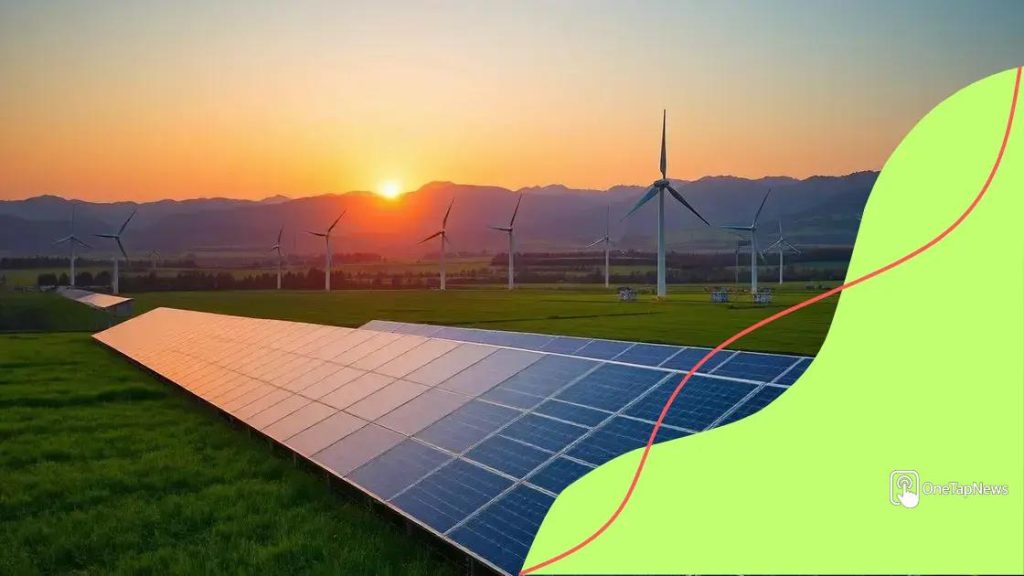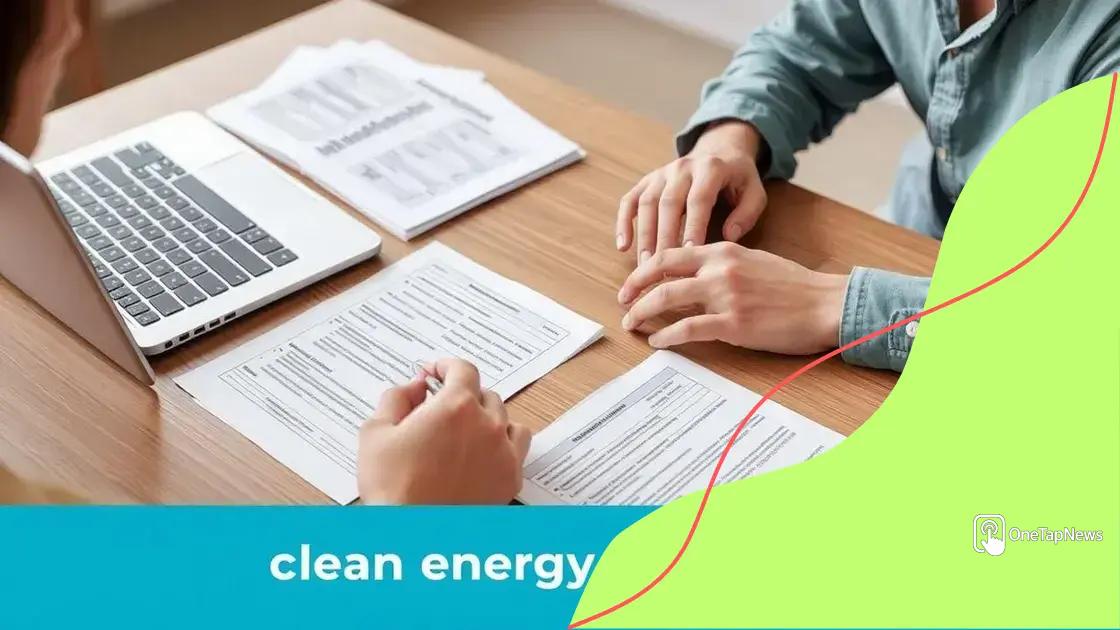Federal clean energy incentives: your guide to savings

Anúncios
Federal clean energy incentives provide financial benefits like tax credits, rebates, and grants to promote the adoption of renewable energy technologies, helping individuals and businesses save money while supporting sustainability efforts.
Federal clean energy incentives play a crucial role in encouraging individuals and businesses alike to adopt sustainable practices. Have you ever considered how these incentives could reduce your energy bills while helping the environment? In this article, we will explore the different types of incentives and how you can benefit from them.
Anúncios
Understanding federal clean energy incentives
Understanding federal clean energy incentives is essential for anyone looking to save money and contribute to a sustainable future. These programs are designed to encourage the use of clean energy sources.
What are federal clean energy incentives?
Federal clean energy incentives refer to various financial benefits provided by the government to promote renewable energy sources. They come in different forms, such as tax credits, rebates, and grants.
Types of incentives available
There are several types of federal clean energy incentives:
Anúncios
- Investment Tax Credit (ITC): This credit allows you to deduct a percentage of the cost of installing a solar energy system from your federal taxes.
- Residential Renewable Energy Tax Credit: Homeowners can claim a tax credit for the installation of solar, wind, or geothermal energy systems.
- Energy Efficient Mortgage: This program helps homebuyers finance energy efficiency improvements, making homes more affordable.
By taking advantage of these incentives, many households can significantly lower their energy costs. Educating yourself on how these incentives work is the first step towards financial savings and a greener lifestyle.
How to apply for clean energy incentives
Applying for federal clean energy incentives is generally straightforward. Most programs require you to fill out specific forms and provide documentation of your energy-efficient improvements. Different programs may have different application processes, but they typically include:
- Filling out tax forms that reflect your energy investments.
- Collecting receipts and documentation to support your claims.
- Filing your application within the designated timeframe.
Make sure to review the eligibility requirements before applying. Many incentives have specific criteria that must be met to qualify, which can vary by state and program.
Awareness of availability and updating yourself with any changes in legislation is vital. Federal clean energy incentives change periodically, so staying informed allows you to take full advantage of financial savings.
Types of incentives available
There are various types of federal clean energy incentives available to those interested in making environmentally friendly choices. Understanding these options can help individuals and businesses save money while promoting a healthier planet.
Direct Financial Incentives
Many programs offer direct financial incentives as a way to lower the initial costs associated with clean energy installations. These can include:
- Rebates: These are cash returns offered after you purchase and install a qualified renewable energy system.
- Grants: Some organizations provide grants that do not need to be repaid. These can help cover the costs of energy efficiency improvements.
- Tax Credits: Tax credits allow you to subtract a portion of the installation cost from your total taxes owed, directly reducing your tax bill.
Loan Programs
Another type of incentive is low-interest loan programs aimed at making clean energy upgrades more accessible. These loans can be used for various projects, including:
- Solar installations.
- Home insulation improvements.
- Energy-efficient heating systems.
These loans typically feature favorable terms such as lower interest rates and longer repayment periods, making it easier to invest in clean energy.
In addition to financial incentives, there are also support programs that educate homeowners on energy-efficient practices. Accessing these resources can provide valuable knowledge about how to achieve energy savings effectively.
By leveraging these diverse incentives, you can significantly reduce your energy costs while contributing to the country’s shift towards sustainable energy practices. Each program has specific eligibility requirements, so it’s important to research thoroughly to maximize your benefits.
How to apply for clean energy incentives

Applying for clean energy incentives can seem complex, but breaking it down into manageable steps makes the process easier. Understanding the requirements and planning ahead is essential for maximizing your benefits.
Gather Necessary Documentation
The first step in applying for incentives is to collect all necessary documentation. This may include:
- Receipts from your clean energy purchases or installations.
- Details about the energy-efficient systems you have installed.
- Tax forms related to your incentives.
Having this information ready will streamline your application process and help avoid delays.
Research Available Programs
Next, it’s crucial to research available programs specific to your state or locality. Different states may have different incentives tailored to local energy needs. You can start by checking:
- Your state energy office website.
- Local utility company programs.
- Federal websites that list available incentives.
These resources will provide detailed information on how to apply and any eligibility criteria you need to meet.
It’s recommended to also check the deadlines for applications, as missing a deadline can mean losing out on valuable financial support. Each incentive program may have its own rules regarding submission and documentation.
Once you have gathered your documents and researched the options, you can begin the application process. This could involve filling out online forms, mailing applications, or submitting documents in person, depending on the program.
Reviewing your application before submission is vital. Ensure all information is accurate and that you’ve included all required documents. This careful attention can prevent delays or denials in your application.
Maximizing savings with incentives
Maximizing savings with incentives involves strategic planning and informed decisions regarding your clean energy investments. By understanding how to effectively utilize available programs, you can greatly enhance your financial benefits.
Understand the Eligibility Requirements
Your first step in maximizing savings is to thoroughly understand the eligibility requirements for each incentive program. By knowing what you qualify for, you can avoid applications that might not yield any benefits. This knowledge can save you valuable time and effort.
Combine Multiple Incentives
Many homeowners do not realize they can combine multiple incentives. For example, if a federal program offers a tax credit, you may also apply for a state rebate on the same installation. This can significantly increase your total savings. Consider the following options:
- Federal tax credits.
- State rebates.
- Local utility incentives.
By stacking these incentives, you maximize the financial impact of your clean energy projects.
Invest in Energy-Efficient Upgrades
Investing in energy-efficient upgrades not only helps the environment but can also qualify you for various incentives. Whether it’s upgrading to energy-efficient windows or installing a more efficient HVAC system, these improvements can lead to substantial savings in both energy costs and eligible incentives.
Monitoring your energy use helps in finding areas where improvements could yield savings. By keeping track of your energy consumption, you can make more informed choices about upgrades that will qualify for incentives.
Lastly, keeping informed about changing regulations and new programs ensures that you don’t miss out on any opportunities for savings. Incentive programs can evolve, so staying engaged can help you capitalize on the latest offers.
Future of clean energy initiatives
The future of clean energy initiatives is shaped by rapidly changing technology and shifting policies. With increasing awareness of climate change, more governments are committing to ambitious renewable energy goals.
Innovative Technologies
Advancements in technology are driving the clean energy sector forward. Newer technologies such as:
- Solar energy: More efficient solar panels that generate energy even in low-light conditions.
- Energy storage: Improved battery storage solutions to store energy for use when the sun isn’t shining.
- Smart grids: Enhanced grid management that optimizes energy distribution and usage.
These innovations are expected to lower costs and increase efficiency for consumers and businesses alike.
Government Policies
Government policies play a key role in promoting clean energy. Many countries are launching initiatives to support renewable energy production, including:
- Increased subsidies for renewable energy projects.
- Stricter regulations on fossil fuel emissions.
- Long-term goals for reaching net-zero emissions.
Such measures create a favorable environment for investment in clean energy, paving the way for growth in this sector.
The shift towards clean energy is not just a trend; it’s becoming a necessity for sustainability. Companies and individuals are increasingly recognizing the financial benefits of energy efficiency and sustainability. As more people choose environmentally friendly options, there will be greater demand for innovative clean energy solutions.
Overall, the future of clean energy initiatives looks promising. With technology advancements and supportive policies, the transition to a sustainable energy future is not just possible, but on the horizon.
FAQ – Frequently Asked Questions about Federal Clean Energy Incentives
What are federal clean energy incentives?
Federal clean energy incentives are financial benefits like tax credits, rebates, and grants offered by the government to promote renewable energy adoption.
How can I apply for clean energy incentives?
To apply for clean energy incentives, gather necessary documentation, research available programs, and submit your application with accurate information.
Can I combine multiple clean energy incentives?
Yes, many homeowners can combine federal, state, and local incentives to maximize their savings on clean energy investments.
What types of technologies are supported by these incentives?
Incentives support various technologies including solar panels, energy-efficient appliances, and electric vehicle charging stations.